 W
WThe Type 1 37 mm anti-tank gun was an anti-tank gun developed by the Imperial Japanese Army, and used in combat during World War II. The Type 1 number was designated for the year the gun was accepted, 2601 in the Japanese imperial year calendar, or 1941 in the Gregorian calendar.
 W
WThe Type 1 47 mm anti-tank gun was an anti-tank gun developed by the Imperial Japanese Army, and used in combat during World War II. The Type 1 number was designated for the year the gun was accepted, 2601 in the Japanese imperial year calendar, or 1941 in the Gregorian calendar.
 W
WThe Type 10 or 12 cm/45 10th Year Type naval gun was a Japanese 120 mm calibre dual purpose anti-aircraft and coastal defense gun used during the Second World War. It was derived from the 12 cm/45 3rd Year Type naval gun. The Type 10 number was designated for the year the gun was accepted, the 10th year of Emperor Taishō's reign, 1927 in the Gregorian calendar. It served as the secondary armament on a number of Japanese aircraft carriers and cruisers and as the main armament on smaller ships, in single or twin mountings.
 W
WThe Type 11 37 mm infantry support gun was an infantry support gun used by the Imperial Japanese Army in the Second Sino-Japanese War and World War II. The Type 11 designation was given to this gun as it was accepted in the 11th year of Emperor Taishō's reign (1922).
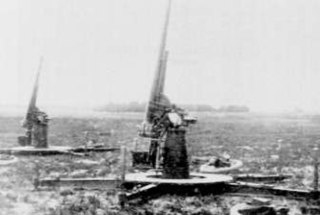 W
WThe Type 11 75 mm anti-aircraft gun was an anti-aircraft gun used by the Imperial Japanese Army after World War I. The Type 11 designation was given to this gun as it was accepted in the 11th year of Emperor Taishō's reign (1922). It was the first anti-aircraft gun in Japanese service, but only a small number were produced, and it was superseded by the Type 14 10 cm gun and the Type 88 75 mm gun in active service before the start of World War II.
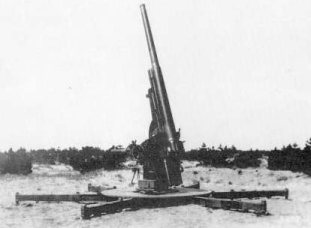 W
WThe Type 14 10 cm AA gun was an anti-aircraft gun used by the Imperial Japanese Army after World War I. The Type 14 number was designated for the year the gun was accepted, the 14th year of Emperor Taishō's reign, 1929 in the Gregorian calendar. Only a small number were produced, and it was superseded by the Type 88 75 mm AA gun in production before the start of World War II.
 W
WThe Type 14 10 cm cannon was the first medium caliber cannon totally of Japanese design and the first with a split trail carriage. The Type 14 designation was given to this gun as it was accepted in the 14th year of Emperor Taishō's reign (1925). It was used Imperial Japanese Army but was not considered successful and was replaced by the Type 92 10 cm cannon.
 W
WThe Type 3 12 cm AA gun was an anti-aircraft gun used in quantity by the Imperial Japanese Army during World War II.The Type 3 number was designated for the year the gun was accepted, 2603 in the Japanese imperial year calendar, or 1943 in the Gregorian calendar. It replaced the earlier Type 88 75 mm AA Gun in Japanese service.
 W
WThe Type 38 10 cm cannon was a field gun used by the Imperial Japanese Army during World War I, the Second Sino-Japanese War and World War II. It was a licensed copy of a 1905 Krupp design. The Type 38 designation was given to this gun as it was accepted in the 38th year of Emperor Meiji's reign (1905). By 1941 it was thoroughly obsolete and relegated to second-line service.
 W
WThe Type 38 12 cm howitzer (1905) is an obsolete Japanese field piece used by the Imperial Japanese Army during World War I, Second Sino-Japanese War, and World War II. The Type 38 designation was given to this gun as it was accepted in the 38th year of Emperor Meiji's reign (1905). It was encountered by Allied forces for the first time on Iwo Jima, and it may have been used as an emergency or substitute weapon.
 W
WThe Type 38 15 cm Howitzer was a 1905 German design that was purchased by the Empire of Japan as the standard heavy howitzer of the Imperial Japanese Army at the end of the Russo-Japanese War. The Type 38 designation was given to this gun as it was accepted in the 38th year of Emperor Meiji's reign (1905).
 W
WThe Type 38 75 mm field gun was a 1905 German design which was purchased by the Empire of Japan as the standard field gun of the Imperial Japanese Army at the end of the Russo-Japanese War. The Type 38 designation was given to this gun as it was accepted in the 38th year of Emperor Meiji's reign (1905).
 W
WThe 20 cm naval rocket launcher was a rocket artillery system used by the Imperial Japanese Navy in the final stages of World War II.
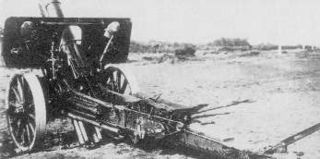 W
WThe Type 4 15 cm Howitzer was a heavy howitzer used by the Imperial Japanese Army during the Second Sino-Japanese War and World War II. The Type 4 designation was given to this gun as it was accepted in the 4th year of Emperor Taishō's reign (1915).
 W
WThe Type 4 20 cm rocket mortar was a 203 mm rocket mortar used by the Imperial Japanese Army in the final stages of World War II.
 W
WThe Type 4 40 cm rocket mortar was a 400 mm (16 in) rocket used by the Imperial Japanese Army in the final stages of World War II.
 W
WThe Type 4 75 mm AA gun was an anti-aircraft gun developed by the Imperial Japanese Army. They started producing the gun in 1943. The Type 4 number was designated for the year the gun was accepted, 2604 in the Japanese imperial year calendar, or 1944 in the Gregorian calendar. Due to the lack of raw materials available and the great damage by air raids to its industrial infrastructure, only 70 units were made. These units were retained for defense of the Japanese home islands during World War II.
 W
WThe Type 41 75 mm cavalry gun was a Japanese field gun first accepted into service in 1908. The Type 41 designation was given to this gun as it was accepted in the 41st year of Emperor Meiji's reign (1908). It was a slightly lightened version of the Type 38 75 mm field gun that was based on a 1905 Krupp design. It was the primary weapon of artillery units attached to cavalry formations. Although effectively obsolete by the start of World War II, it was used in limited numbers despite nominally being replaced by the Type 95 75 mm field gun.
 W
WThe Type 41 75 mm mountain gun is a Japanese license-built copy of the recoiling Krupp M1908 mountain gun. The Type 41 number was designated for the year the gun was accepted, the 41st year of Emperor Meiji's reign, 1908 in the Gregorian calendar after the conclusion of the Russo-Japanese War. Originally it was the standard pack artillery weapon. After it was superseded by the Type 94 75 mm mountain gun, it was then used as an infantry "regimental" gun, deployed four to each infantry regiment, and referred to as "rentai ho". Two gun shields were produced for the weapon, an early type, which folded into thirds, and a late type, which folded in half.
 W
WThe Type 45 240 mm howitzer was a siege gun used by the Imperial Japanese Army during World War I and World War II. The Type 45 designation was given to this gun as it was accepted in the 45th year of Emperor Meiji's reign (1912). It was the first such weapon to be entirely designed in Japan.
 W
WThe Type 5 15 cm AA gun was a large caliber anti-aircraft gun developed by the Imperial Japanese Army during the final days of World War II. The Type 5 number was designated for the year the gun was accepted, 2605 in the Japanese imperial year calendar, or 1945 in the Gregorian calendar. It was intended to replace the earlier Type 3 12 cm AA Gun as a defense against American air raids.
 W
WThe Type 88 75 mm AA gun was an anti-aircraft gun used by the Imperial Japanese Army during the Second Sino-Japanese War and World War II. The Type 88 number was designated for the year the gun was accepted, 2588 in the Japanese imperial year calendar, or 1928 in the Gregorian calendar. It replaced the earlier Type 11 75 mm AA gun in front line combat service, and at the time was equal in performances to any of its contemporaries in western armies and was considered capable of handling any targets the Japanese army was likely to encounter on the Asian mainland. Although it was soon overtaken by improvements in aircraft technology and was largely obsolete by 1941, it continued to be used on many fronts until the end of the war.
 W
WThe Type 89 15 cm cannon was the main gun of the Imperial Japanese Army's heavy artillery units. The Type 89 designation was given to this gun as it was accepted in the year 2589 of the Japanese calendar (1929). It was widely used from the Manchurian Incident to the end of World War II, for example, Nomonhan, Bataan and Corregidor Island, Okinawa. The Type 89 15 cm gun was comparable to the U.S. M1918 155 mm GPF cannon, but the Type 89 had shorter range. The Type 89 was less efficient than similar heavy-caliber guns of other nations in World War II.
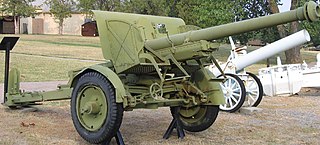 W
WThe Type 90 75 mm field gun was a field gun used by the Imperial Japanese Army during the Second Sino-Japanese War, Soviet-Japanese Border Wars and World War II. The Type 90 designation was given to this gun as it was accepted in the year 2590 of the Japanese calendar (1930). It was intended to replace the Type 38 75 mm field gun in front line combat units, but due to operational and budgetary constraints, the Type 38 continued to be used.
 W
WThe Type 90 240 mm railway gun was a large caliber railroad gun acquired by the Imperial Japanese Army from the French arms manufacturer Schneider in 1930. The Type 90 designation was given to this gun as it was accepted in the year 2590 of the Japanese calendar (1930). It was the only railroad gun in Japanese service.
 W
WThe Type 91 10 cm howitzer was a 105 mm (4.13 in) howitzer used by the Imperial Japanese Army during the Second Sino-Japanese War and World War II. The Type 91 number was designated for the year the gun was accepted, 2591 in the Japanese imperial year calendar, or 1931 in the Gregorian calendar.
 W
WThe Type 92 10 cm cannon was a field gun used by the Imperial Japanese Army during the Second Sino-Japanese War and World War II. The Type 92 number was designated for the year the gun was accepted, 2592 in the Japanese imperial year calendar, or 1932 in the Gregorian calendar. The Type 92 cannon was intended to supersede the Type 14 10cm cannon in front-line combat service.
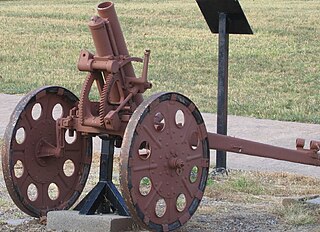 W
WThe Type 92 battalion gun was a light howitzer used by the Imperial Japanese Army during the Second Sino-Japanese War and World War II. The Type 92 designation was for the year the gun was accepted, 2592 in the Japanese imperial year calendar, or 1932 in the Gregorian calendar. Each infantry battalion included two Type 92 guns; therefore, the Type 92 was referred to as "battalion artillery" .
 W
WThe Type 94 37 mm quick-firing gun was an anti-tank gun developed by the Imperial Japanese Army. It was used in combat during the Second Sino-Japanese War and World War II. The Type 94's number was designated for the year the gun was accepted, 2594 in the Japanese imperial year calendar, or 1934 in the Gregorian calendar.
 W
WThe Type 94 75 mm mountain gun was a mountain gun used as a general-purpose infantry support gun by the Imperial Japanese Army during the Second Sino-Japanese War and World War II. It superseded the Type 41 75 mm mountain gun to become the standard pack artillery piece of Japanese infantry divisions. It was superior to the Type 41 in range and in weight. The Type 94 number was designated for the year the gun was accepted, 2594 in the Japanese imperial year calendar, or 1934 in the Gregorian calendar.
 W
WThe Type 95 75 mm field gun was a field gun used by the Imperial Japanese Army during World War II. It was intended to replace the Type 38 75 mm field gun and the Type 41 75 mm cavalry gun in front line combat units but, due to operational and budgetary constraints, only a small number were produced, and the Type 38 and Type 41 continued to be used. The Type 95 number was designated for the year the gun was accepted, 2595 in the Japanese imperial year calendar, or 1935 in the Gregorian calendar.
 W
WThe Type 96 15 cm howitzer was a 149.1 mm calibre howitzer used by the Imperial Japanese Army during World War II. It was intended to replace the Type 4 15 cm howitzer in front line combat units from 1937, although it fired the same ammunition. The Type 96 designation was given to this gun as it was accepted in the year 2596 of the Japanese calendar (1936).
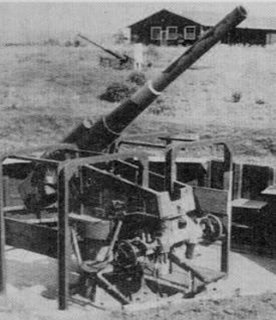 W
WThe Type 99 88 mm AA gun was an anti-aircraft gun used by the Imperial Japanese Army during World War II. The Type 99's number was designated for the year the gun was accepted, 2599 in the Japanese imperial year calendar.
 W
WThe 45 cm naval rocket was a rocket artillery system used by garrison troops of the Imperial Japanese Navy during the late stages of World War II in defense of island bases in the Pacific.
 W
WThe Type 5 75 mm tank gun was used as the main armament of the Imperial Japanese Army prototype Type 4 Chi-To medium tank. It was one of the largest tank guns to be fitted on a World War II Japanese tank. Due to late war shortage-induced delays only two were ever mounted in a completed Type 4 Chi-To, neither of which saw combat use. The tank gun was also used on the prototype Type 5 Chi-Ri medium tank and prototype Type 5 Na-To tank destroyer.
 W
WThe Type 7 30 cm howitzer was a howitzer used by the Imperial Japanese Army in the Second Sino-Japanese War, Soviet–Japanese border conflicts and during the Pacific Campaign in World War II. The designation Type 7 indicates its year of introduction, the seventh year of the reign of Emperor Taishō, or 1918 according to the Gregorian calendar.
 W
WThe Type 10 and Type 3 rocket boosters were rocket artillery systems used by garrison troops of the Imperial Japanese Navy during the late stages of World War II in defense of island bases in the Pacific.
 W
WThe Type 21 and Type 22 rocket-bombs were rocket artillery systems used by garrison troops of the Imperial Japanese Navy during the late stages of World War II in defense of island bases in the Pacific.
 W
WThe Type 45 15 cm cannon (四五式十五糎加農砲) was a coastal defense gun and heavy artillery used by the Imperial Japanese Army during the World War II. The designation Type 45 indicates the year of its introduction, the 45th year of the Meiji period or 1912 according to the Gregorian calendar.
 W
WThe Type 93 13 mm heavy machine gun, known to the Imperial Japanese Army as the Type Ho 13 mm AA machine cannon, was a license-built version of the Hotchkiss M1930 machine gun used by the Empire of Japan during the Second Sino-Japanese War and World War II.
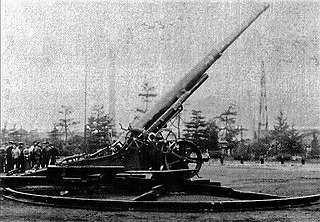 W
WThe Type 96 15 cm cannon was a siege gun used by the Imperial Japanese Army in the Japanese-Soviet War and during the Pacific War from 1936 to 1945. The designation Type 96 indicates the year of its introduction, Kōki year 2596 or 1936 according to Gregorian calendar.
 W
WThe Type 96 24 cm howitzer was a siege gun used by the Imperial Japanese Army in the Japanese-Soviet War and during the Pacific War from 1936 to 1945. The designation Type 96 indicates the year of its introduction, Kōki year 2596 or 1936 according to Gregorian calendar.